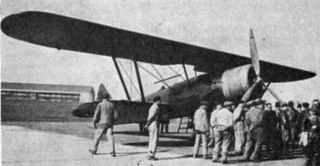Related Research Articles

The Potez 37 was a two-seat, long range reconnaissance aircraft built to compete for a French government contract. It flew in mid-1930 but did not win the competition, so only two were completed.
The Potez 26 was a single seat fighter aircraft designed and flown in France in the mid-1920s. It did not reach production.

The Potez 35 was a twin engine bomber aircraft, designed and built in France in the late 1920s. Only one was completed.

The Potez 40 was a French three-engine, braced high-wing monoplane designed and built in response to a French government programme for colonial transport and policing aircraft duties.

The Potez 31 was a prototype French two-seat night fighter, flown in about 1928, intended to fill the Cn.2 specification for the Armee de l'Air. Only one was built.
The Potez 38 was a French single engine, eight or nine seat passenger aircraft flown in 1930. Only one was built.
The Potez 27 was a French reconnaissance biplane first flown in 1924. 175 were operated by the Polish Air Force, most built in Poland by PWS under licence. Others went to Romania, where they were also used as light bombers.
The Bassou Rubis (Ruby) was a low power, robust French aircraft designed for basic training and touring.
The Peitz 101, aka Peitz Avionette, was a French, amateur-built, all-metal light aircraft, first flown during the winter of 1931–32.
The Weymann W-100, Weymann CTW-100 or Weymann W-100 RBL was a French three seat observation aircraft with a position for the observer within its partially glazed fuselage. Only one was built.

The Potez 50 or Potez 50 A2 was a French two seat military multi-rôle aircraft, first flown in 1931. It did not go into service but seven variants using five different engines were produced, one of them setting several speed with useful load records and another, the Potez 506, setting three altitude world records.
The Renard R.33 was a Belgian training aircraft with aerobatic capability. Two were flown in 1934 but no more were produced.

The Weymann-Lepère WEL-80 R.2 was a French two seat reconnaissance aircraft built to compete for a 1928 government contract. It was not successful and did not enter production.
The Morane-Saulnier MS.300 and MS.301 were French parasol wing introductory trainer aircraft, first flown in 1930. They differed only in engine type. Neither reached production but were developed into two similar trainers, the MS.230 and MS.315, which were made in large numbers.
The Potez 42 was designed and built in 1930 to meet a French government requirement for a small air ambulance capable of operating in the colonies. It did not reach production.

The Albatros L 83 Adler was a small, fast transport aircraft for passengers, mail or other cargo, flown in Germany in 1931. Two were built.

The Lioré et Olivier LeO H-23 was a French military flying boat, primarily intended for coastal reconnaissance, though able to carry a small bomb load. Only one was built.
The S.A.B.C.A. S.XII or S.A.B.C.A S.12 was a four-passenger light transport aircraft with three engines and a high wing, built in Belgium in the early 1930s.

The Aerial Service Mercury Senior, Aerial Mercury Senior or just Mercury Senior was a US biplane mailplane designed to operate at night between New York City and Chicago. A different, smaller, lower wing improved its performance for daytime flights. One was built and used by the United States Post Office Department.

The Hanriot H.25 was a French, single-engined, six passenger airliner built in 1926. Only one was flown.
References
- 1 2 3 4 5 "Le monoplan Henri Potez type 51". Les Ailes (635): 3. 17 August 1933.
- 1 2 "A Méaulte". Les Ailes (633): 14. 17 August 1933.
- ↑ "The French Aero Show - Henry Potez". Flight . XXIV (48): 1111. 24 November 1932.
- ↑ "Le biplace Potez 51". L'Aéronautique. 163: 175. December 1932.
- ↑ "A Méaulte". Les Ailes (606): 14. 26 January 1933.
- ↑ "A Méaulte". Les Ailes (647): 14. 9 November 1933.
- ↑ "A Méaulte". Les Ailes (663): 14. 1 March 1933.
- ↑ "A Méaulte". Les Ailes (665): 14. 15 March 1933.